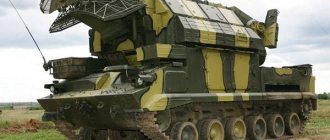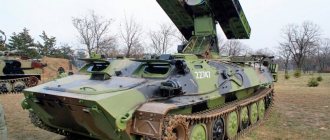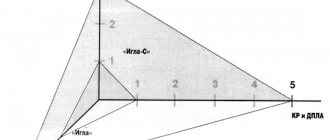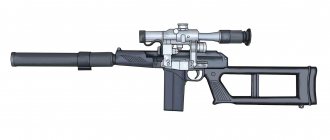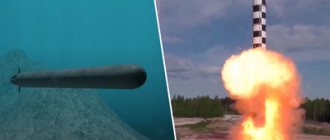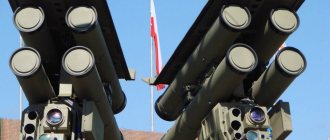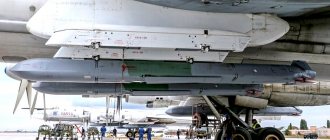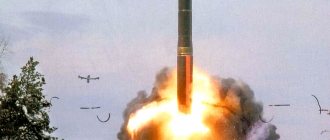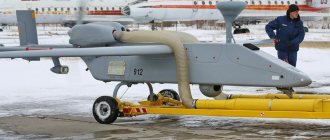ZRPK 2K22 "Tunguska"
Anti-aircraft missile and gun complex (ZRPK)
- a complex designed to cover troops and objects from attacks by air attack weapons, primarily attack helicopters and attack aircraft operating at extremely low, low and medium altitudes, as well as for firing at lightly armored ground and surface targets.
As a rule, ZRPK and ZRAK (anti-aircraft missile and artillery complex) are simply called ZRK (anti-aircraft missile system) [ source not specified 2562 days
] or, when the complex is placed on a self-propelled base - ZSU (anti-aircraft self-propelled unit).
A classic representative of the air defense system is the Russian 2K22 Tunguska complex. Its armament consists of two twin 2A38 automatic cannons of 30 mm caliber and eight 9M311 short-range anti-aircraft guided missiles. The guns have a total rate of fire of about 4000 rounds/min.
Story
Small-caliber anti-aircraft artillery demonstrated its effectiveness during the Second World War. But with the development of jet aviation, the need arose to cover troops directly from their combat formations during an offensive. This is how the Shilka and Vulkan self-propelled guns appeared.
With the development of missile weapons, a need arose for anti-aircraft missiles of various ranges, since anti-aircraft artillery had a short range. Combining missile and artillery weapons into a single complex made it possible to compensate for the short firing range of an artillery installation with a longer range of missiles, and the possibility of suppressing the missile guidance system by enemy electronic warfare systems with artillery fire, which is not subject to optical and electronic suppression systems.
Anti-aircraft missile and gun complex Pantsir-S1
Pantsir-S1
(GRAU index - 96K6, according to NATO codification - SA-22 Greyhound) is a Russian ground-based self-propelled anti-aircraft missile and gun system (ZRPK), developed by the Tula State Unitary Enterprise Instrument Design Bureau. Designed for short-range cover of civilian and military targets (including long-range air defense systems) from all modern and future air attack weapons. It can also protect the defended object from ground and surface threats.
The complex was created in 1994 and was first demonstrated at MAKS-1995. Since that time, the complex has been significantly modernized, the last known modification was demonstrated at MAKS-2007. On March 18, 2010, the first serial “shells” entered service with the Russian Armed Forces. A representative of the design bureau suggests that in the future the Pantsir-S1 will completely replace the Tunguska air defense missile system in the Russian army.
Description
Pantsir-S1 is a short-range anti-aircraft missile and gun system, placed on the chassis of a truck, trailer or permanently installed. Management is carried out by two or three operators. Air defense is carried out by automatic cannons and guided missiles with radio command guidance with IR and radio direction finding. The complex is designed to protect civilian and military target targets from platoon to regiment or to cover long-range air defense systems such as S-300/S-400.
Airborne targets include all targets with a minimum reflective surface speed of up to 1000 m/s and a maximum range of 20,000 meters and an altitude of up to 15,000 meters, including helicopters, unmanned aerial vehicles, cruise missiles and precision bombs.
Operation of the complex
The peculiarity of the Pantsir-S1 complex is the combination of a multi-channel target acquisition and tracking system with cannon and artillery weapons, creating a continuous target interception zone from 5 m in height and 200 m in range to 15 km in height and 20 km in range, even without external support.
Up to 6 Pantsir-S1 vehicles can work together via a digital communication network in various modes.
- Single combat operations: all actions, from target detection to its interception, are completely carried out by a single complex without the involvement of other means.
- Combat operations as part of a battery: one Pantsir-S1 works both as a combat vehicle and as a command post. From 3 to 5 Shells can be connected to it and receive target designations for subsequent task completion.
- Combat operations with the command post: the command post sends target indications to the Pantsir-S1 installations for subsequent execution of the mission.
- Combat operations as part of a battery with a command post and an early warning radar: the command post receives the air situation from the early warning radar and sends target designations to the Pantsir-S1 installations for subsequent mission execution.
It can operate in automatic mode both in a separate combat unit and as part of a unit of several combat vehicles.
Detection, tracking and fire control system
Pantsir-S1 (target tracking radar in the center) - two double-barreled anti-aircraft guns and 12 surface-to-air missiles ready for launch
The fire control system of the Pantsir-S1 complex includes a detection radar (based on phased arrays) and two tracking radars (this radar tracks both targets and surface-to-air missiles launched by the complex. For targets with an effective dispersion area of 2 m², the detection range is 32-36 km .
In addition to the radar, the fire control system also contains an optical-electronic complex with a long-wave thermal receiver (infrared direction finder), and also carries out digital signal processing and automatic target tracking. There is a simplified and cheaper version of the Pantsir-S1 for export, which contains only an optical-electronic fire control system.
Two independent guidance means - a radar and an optical-electronic system - allow you to capture two targets simultaneously. The maximum acquisition speed is 10 targets per minute.
In service
It is known that there is a portfolio of orders for Pantsir-S1 worth $2.5 billion. Based on the cost of each air defense missile system, this means a total order of more than 175 units.
- Algeria - 38 complexes ordered (Contract amount: more than $500 million).
- Iran - 10
- Morocco - Estimated order, 50 complexes
- UAE - 50 complexes delivered (Contract amount: $734 million).
- Oman 12
- Russia - by March 18, 2010, 10 complexes
- Syria - 36 complexes (ordered), 10 complexes delivered.
| Main characteristics | |
| Type: | anti-aircraft missile and gun complex |
| Manufacturer: | KBP (Tula) |
| State: | In service |
| Years of operation: | 2008 - present |
| Crew: | 3 persons |
| Complex weight: | up to 30 tons (depending on chassis) |
| Deployment time: | < 5 minutes |
| Reaction time: | 4-6 sec |
| Ammunition: | 12 57E6-E missiles, 1400 shells |
| Detection system characteristics | |
| Radar: | 1RS1-1E and 1RS2 |
| Radar type: | Dual-band three-axis |
| Antenna type: | PAR |
| Range: | cm/mm (tracking channel) and cm (detection channel) |
| Survey azimuth (detection/tracking): | 60/45 degrees (360 due to mechanical rotation) |
| Viewing angle (detection/tracking): | 60/45 degrees |
| Range (RCS 2 m²) (detection/tracking): | 36/30 km |
| Optical-electronic tracking systems: | There is |
| Line of sight: | 1.8 x 2.7 degrees |
| Modes: | automatic/manual |
| Range: | 18 km |
| Missile weapons (57E6-E) | |
| Type: | two-stage supersonic solid propellant |
| Guidance: | radio command |
| Speed (maximum / at a distance of 18 km): | 1300/780 m/s |
| Maximum target speed: | 1000 m/s |
| Range to target: | 1.2 km – 20 km |
| Target altitude: | 5 m - 15 km |
| Length: | 3.2 m |
| Caliber: | 170/90 mm |
| Weight (without/with TPK): | 74.5/94 kg |
| Warhead type: | core |
| Warhead mass: | 20 kg |
| Weight of explosive warhead: | 5.5 kg |
| Cannon armament (2A38M) | |
| Type: | twin anti-aircraft gun |
| Caliber: | 30 mm |
| Effective maximum firing range: | 4 km |
| Total rate of fire: | 5000 rounds/min |
| Barrel survivability: | >8000 shots |
| Ammo type: | armor-piercing incendiary |
| Initial bullet speed: | 960 m/s |
| Cartridge weight: | 842 g |
| Projectile weight: | 389 g |
Dear readers! Subscribe to us on Twitter, Vkontakte, Odnoklassniki or Facebook.
Main differences from other complexes
Unlike other similar systems that are in service with the Russian army, this equipment was initially mounted on an all-terrain chassis with an 8x8 wheel arrangement. This circumstance allows the Pantsir to be used in places where such complexes cannot reach under their own power. How were they able to achieve such outstanding characteristics?
For this purpose, the Ural-5323.4 vehicle was chosen as the basis, on which a KamAZ-7406 engine was installed. The engine has undergone some modernization, as a result of which its power was increased to 260 horsepower. Why did the designers use a wheeled chassis, although it is generally known that the cross-country ability of tracked vehicles is much higher? It’s simple: since the main purpose of Pantsir-S 1 is to protect columns of equipment on the march and cover the rear, you need a lot of these complexes.
Under these circumstances, it would be strange to make expensive equipment. And no one doubts the fact that tracked tractors belong precisely to this category. In addition, such equipment consumes a lot of fuel, which is again unacceptable for the complex, which must follow the columns of the equipment it is accompanying under its own power.
Chassis
| Chassis index | KamAZ-6560 | GM352M1E | BAZ-6306 Voshchina-1 | MAN |
| Appearance | ||||
| Wheel formula | 8x8 | crawler | 8x8 | 8x8 |
| Maximum speed | 90 km/h | 70 km/h | ||
| Booking | bulletproof | anti-ballistic | bulletproof | bulletproof |
| Power reserve | 500 km | 600 km |
Literature
- Firsov V. M., Morgunov M. A., Zhovner V. G., Valentinov V. G., Novokshonov V. F., Bedulya A. V., Popov V. P., Poltavtsev A. P., Pishchenko V. N., Babich I. N.
Anti-aircraft gun and missile system "Tunguska". Textbook for the Air Defense Forces of the Ground Forces / Zhdanovich B.K. - M.: Military Publishing House of the USSR Ministry of Defense, 1991. - 248 p. - Tikhonov S.G.
Defense enterprises of the USSR and Russia: in 2 volumes. - M.: TOM, 2010. - T. 1. - 608 p. — 1000 copies. — ISBN 978-5-903603-02-2. - Tikhonov S.G.
Defense enterprises of the USSR and Russia: in 2 volumes. - M.: TOM, 2010. - T. 2. - 608 p. — 1000 copies. — ISBN 978-5-903603-03-9. - Anatoly Sokolov.
“Tunguska” - continuation of “Shilka” (Russian) // “Armor”. - M., 2009. - No. 1. - P. 8-16.
Compound
The composition of "Tunguska" includes:
- A battery consisting of six 2S6 self-propelled anti-aircraft guns equipped with 9M311 and 2A38 anti-aircraft missiles
- 1Р10 - a maintenance and repair vehicle designed to carry out maintenance-1
- 2B110 - a maintenance vehicle designed to carry out maintenance-2
- 2F55 - maintenance vehicle, partially equipped with single and group spare parts
- 2F77 – TZM, for transporting 1 ammunition load of anti-aircraft guided missiles (one vehicle per installation) and 1.5 ammunition loads of cartridges
- ESD2-12 is a diesel-based power plant designed for external power supply of installations
- 1RL912 is a training device designed to train commanders and installation operators
- 9F810 – a simulator designed for training gunners;
- 9M311UD - training missiles equipped with on-board equipment, used in training installation gunners
- 9М311ГМВ - training dimensions and weight mock-ups of missiles used in testing the standards and handling skills of installation crews
- 9M311UR is a cross-sectional training model of missiles used in studying the design of installations.
In service
- Belarus - a certain amount of 2C6[23]
- India - according to various sources, from 20 to 92 2S6 units, as of 2020[24][25][26]. From 24 to 50 units of 2S6M and 400 units of 9M311 were supplied from Russia between 1997 and 1998[26]. 14 units of 2S6M and 225 units of 9M311 were delivered from Russia in 2002[26]. 28 units of 2S6M and 450 units of 9M311 were supplied from Russia between 2008 and 2009[26].
- Yemen - a certain amount of 2S6M1, as of 2005[27]. According to the Stockholm Peace Research Institute, neither supplies nor licensed production of 2S6M1 have been carried out in Yemen[26].
- Morocco - 12 2K22M complexes, as of 2016[28]
- Myanmar - some amount 2K22M1, as of 2016[29]. 38 units of 2С6М and 600 missiles of 9М311 were delivered from Russia in the period from 2004 to 2007[26]
- Russia - more than 250 2K22 complexes, as of 2016[30]
- Ukraine - 70 2S6 units, as of 2020[31]
- Syria - 6 2S6M1 units delivered in 2008[32]
Monuments and museum exhibits
| Type | Board number | Location | Image |
| Monument in the city of Kovylkino, Republic of Mordovia, Russia | |||
| Exhibit at the Museum of Russian Military History in the village of Padikovo, Istrinsky district, Moscow region, Russia |
Device
Combat vehicle 2S6M ZPRK Tunguska-M
The main components of the complex are:
- self-propelled tracked lightly armored chassis GM-5975.25[18]
- two 30-mm anti-aircraft guns 2A38
- 8 launchers with ammunition consisting of 8 9MZ11 anti-aircraft guided missiles
- radar system consisting of a target acquisition radar, a target tracking radar and a ground radio interrogator
The 9M311 rocket consists of two stages. The first stage engine runs on solid fuel, the body is made of fiberglass. The second stage is designed without an engine, the flight proceeds by inertia, and a gas generator is located in the tail section, providing better aerodynamic flow conditions. Non-contact fuse, warhead with rod striking elements.
Basic historical information
The concept of a new weapon was first presented relatively recently, at the beginning of 1994.
Just a year after the demonstration of the prototype, a working prototype of this technology was demonstrated at an exhibition in Zhukovsky. Then many experts almost unanimously agreed that Pantsir-S 1 was a real breakthrough in the field of ground air defense systems. The history of the creation of this type of weapon is in many ways phenomenal. The development of a new air defense missile system was ordered by the Tula Design Bureau back in 1990, before the collapse of the USSR. Initially, the work was top secret, carried out under the code name “Roman”. It was assumed that the new equipment would be designed to effectively protect S-300 air defense systems and main air defense radar stations on the country’s vast borders.
Subsequently, such a narrow specialization was abandoned, after which the complex was also transferred to the ground forces, which urgently needed it to reliably cover columns of military equipment on the march, and to pre-emptively destroy certain types of armored vehicles of a potential enemy. At the same time, a version for the fleet was also ordered (it was created and is effectively operated today). The success of the complex is largely due to the fact that it was created on the basis of the famous 2K22 Tunguska.
It should be noted that initially this military equipment (the photo is in the material) did not show its best side. During the tests, it turned out that it is impossible to hit a target at a distance of even several kilometers, that is, the radar systems cope with their functions extremely unsatisfactorily. In addition, the military had numerous complaints related to the low reliability of many installation systems.
